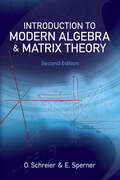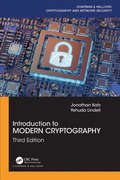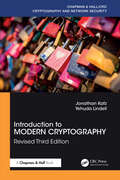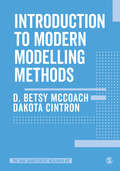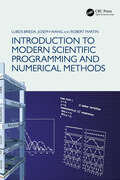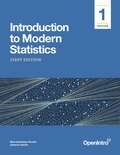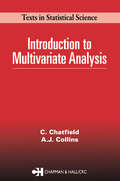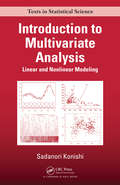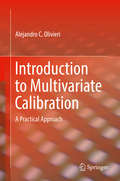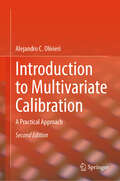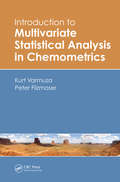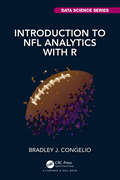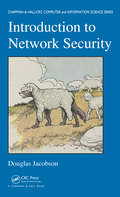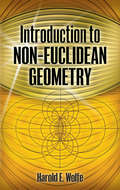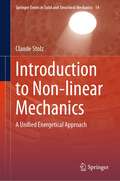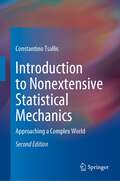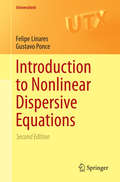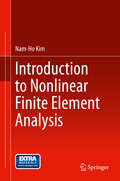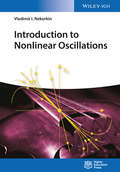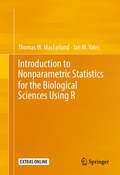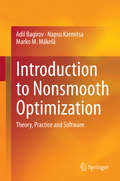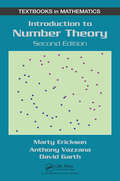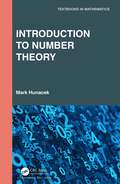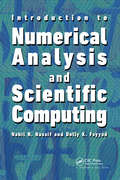- Table View
- List View
Introduction to Modern Algebra and Matrix Theory: Second Edition
by Martin David Melvin Hausner O. Schreier E. SpernerThis unique text provides students with a basic course in both calculus and analytic geometry -- no competitive editions cover both topics in a single volume. Its prerequisites are minimal, and the order of its presentation promotes an intuitive approach to calculus. Algebraic concepts receive an unusually strong emphasis. Numerous exercises appear throughout the text. 1951 edition.
Introduction to Modern Cryptography (Chapman & Hall/CRC Cryptography and Network Security Series)
by Jonathan Katz Yehuda LindellNow the most used texbook for introductory cryptography courses in both mathematics and computer science, the Third Edition builds upon previous editions by offering several new sections, topics, and exercises. The authors present the core principles of modern cryptography, with emphasis on formal definitions, rigorous proofs of security.
Introduction to Modern Cryptography: Fourth Edition (Chapman & Hall/CRC Cryptography and Network Security Series)
by Jonathan Katz Yehuda LindellIntroduction to Modern Cryptography, the most relied-upon textbook in the field, provides a mathematically rigorous yet accessible treatment of this fascinating subject. The authors have kept the book up-to-date while incorporating feedback from instructors and students alike; the presentation is refined, current, and accurate.The book’s focus is on modern cryptography, which is distinguished from classical cryptography by its emphasis on definitions, precise assumptions, and rigorous proofs of security. A unique feature of the text is that it presents theoretical foundations with an eye toward understanding cryptography as used in the real world. This revised edition fixed typos and includes all the updates made to the third edition, including: Enhanced treatment of several modern aspects of private-key cryptography, including authenticated encryption and nonce-based encryption. Coverage of widely used standards such as GMAC, Poly1305, GCM, CCM, and ChaCha20-Poly1305. New sections on the ChaCha20 stream cipher, sponge-based hash functions, and SHA-3. Increased coverage of elliptic-curve cryptography, including a discussion of various curves used in practice. A new chapter describing the impact of quantum computers on cryptography and providing examples of quantum-secure encryption and signature schemes. Containing worked examples and updated exercises, Introduction to Modern Cryptography, Revised Third Edition can serve as a textbook for undergraduate- or graduate-level courses in cryptography, a reference for graduate students, researchers, and practitioners, or a general introduction suitable for self-study.
Introduction to Modern Modelling Methods (The SAGE Quantitative Research Kit)
by D. Betsy McCoach Dakota CintronUsing simple and direct language, this concise text provides practical guidance on a wide range of modeling methods and techniques for use with quantitative data. It covers: · 2-level Multilevel Models · Structural Equation Modeling (SEM) · Longitudinal Modeling using multilevel and SEM techniques · Combining organizational and longitudinal models Part of The SAGE Quantitative Research Kit, this book will give you the know-how and confidence needed to succeed on your quantitative research journey.
Introduction to Modern Modelling Methods (The SAGE Quantitative Research Kit)
by D. Betsy McCoach Dakota CintronUsing simple and direct language, this concise text provides practical guidance on a wide range of modeling methods and techniques for use with quantitative data. It covers: · 2-level Multilevel Models · Structural Equation Modeling (SEM) · Longitudinal Modeling using multilevel and SEM techniques · Combining organizational and longitudinal models Part of The SAGE Quantitative Research Kit, this book will give you the know-how and confidence needed to succeed on your quantitative research journey.
Introduction to Modern Scientific Programming and Numerical Methods
by Joseph Wang Lubos BriedaThe ability to use computers to solve mathematical relationships is a fundamental skill for anyone planning for a career in science or engineering. For this reason, numerical analysis is part of the core curriculum for just about every undergraduate physics and engineering department. But for most physics and engineering students, practical programming is a self-taught process.This book introduces the reader not only to the mathematical foundation but also to the programming paradigms encountered in modern hybrid software-hardware scientific computing. After completing the text, the reader will be well-versed in the use of different numerical techniques, programming languages, and hardware architectures, and will be able to select the appropriate software and hardware tool for their analysis.It can serve as a textbook for undergraduate courses on numerical analysis and scientific computing courses within engineering and physical sciences departments. It will also be a valuable guidebook for researchers with experimental backgrounds interested in working with numerical simulations, or to any new personnel working in scientific computing or data analysis.Key Features: Includes examples of solving numerical problems in multiple programming languages, including MATLAB, Python, Fortran, C++, Arduino, Javascript, and Verilog Provides an introduction to modern high-performance computing technologies including multithreading, distributed computing, GPUs, microcontrollers, FPGAs, and web "cloud computing" Contains an overview of numerical techniques not found in other introductory texts including particle methods, finite volume and finite element methods, Vlasov solvers, and molecular dynamics
Introduction to Modern Statistics
by Mine Çetinkaya-Rundel Johanna HardinIntroduction to Modern Statistics is a re-imagining of a previous title, Introduction to Statistics with Randomization and Simulation. The new book puts a heavy emphasis on exploratory data analysis (specifically exploring multivariate relationships using visualization, summarization, and descriptive models) and provides a thorough discussion of simulation-based inference using randomization and bootstrapping, followed by a presentation of the related Central Limit Theorem based approaches. Other highlights include: <p><p>Web native book. The online book is available in HTML, which offers easy navigation and searchability in the browser. The book is built with the bookdown package and the source code to reproduce the book can be found on GitHub. Along with the bookdown site, this book is also available as a PDF and in paperback. <p><p>Tutorials. While the main text of the book is agnostic to statistical software and computing language, each part features 4-8 interactive R tutorials (for a total of 32 tutorials) that walk you through the implementation of the part content in R with the tidyverse for data wrangling and visualisation and the tidyverse-friendly infer package for inference. The self-paced and interactive R tutorials were developed using the learnr R package, and only an internet browser is needed to complete them. <p><p>Labs. Each part also features 1-2 R based labs. The labs consist of data analysis case studies and they also make heavy use of the tidyverse and infer packages. <p><p>Datasets. Datasets used in the book are marked with a link to where you can find the raw data. The majority of these point to the openintro package. You can install the openintro package from CRAN or get the development version on GitHub.
Introduction to Multivariate Analysis (Chapman And Hall/crc Texts In Statistical Science Ser. #1)
by Chris ChatfieldThis book provides an introduction to the analysis of multivariate data.It describes multivariate probability distributions, the preliminary analysisof a large -scale set of data, princ iple component and factor analysis,traditional normal theory material, as well as multidimensional scaling andcluster analysis.Introduction to Multivariate Analysis provides a reasonable blend oftheory and practice. Enough theory is given to introduce the concepts andto make the topics mathematically interesting. In addition the authors discussthe use (and misuse) of the techniques in pra ctice and present appropriatereal-life examples from a variety of areas includ ing agricultural research,soc iology and crim inology. The book should be suitable both for researchworkers and as a text for students taking a course on multivariate analysis.
Introduction to Multivariate Analysis: Linear and Nonlinear Modeling (Chapman & Hall/CRC Texts in Statistical Science #134)
by Sadanori KonishiThis text shows how to use multivariate analysis to extract useful information from multivariate data and understand the structure of random phenomena. Along with the basic concepts of various procedures in traditional multivariate analysis, the book covers nonlinear techniques for clarifying phenomena behind observed multivariate data. It primarily focuses on regression modeling, classification, discrimination, dimension reduction, and clustering. Many examples and figures throughout facilitate a deep understanding of the multivariate analysis techniques, including how to select the optimal model.
Introduction to Multivariate Calibration: A Practical Approach
by Alejandro C. OlivieriThis book offers an introductory-level guide to the complex field of multivariate analytical calibration, with particular emphasis on real applications such as near infrared spectroscopy. It presents intuitive descriptions of mathematical and statistical concepts, illustrated with a wealth of figures and diagrams, and consistently highlights physicochemical interpretation rather than mathematical issues. In addition, it describes an easy-to-use and freely available graphical interface, together with a variety of appropriate examples and exercises. Lastly, it discusses recent advances in the field (figures of merit, detection limit, non-linear calibration, method comparison), together with modern literature references.
Introduction to Multivariate Calibration: A Practical Approach
by Alejandro C. OlivieriThis book contains several new sections that provide even more in-depth knowledge on the topics. New content on the classical least-squares model, which shows its advantages and limitations in greater detail, was added. Additionally, the book contains a new section on the inverse least-squares model, which explains how it differs from the classical model and its applications in chemometrics. Furthermore, a new chapter on principal component analysis, which covers the concept in greater detail and its applications in chemometrics, is added. This book also includes several real-world examples to help you better understand the topic. Overall, this book provides the reader with even more comprehensive knowledge on chemometrics and multivariate calibration, making it an essential resource for students and professionals alike.
Introduction to Multivariate Statistical Analysis in Chemometrics
by Peter Filzmoser Kurt VarmuzaUsing formal descriptions, graphical illustrations, practical examples, and R software tools, Introduction to Multivariate Statistical Analysis in Chemometrics presents simple yet thorough explanations of the most important multivariate statistical methods for analyzing chemical data. It includes discussions of various statistical methods, such as
Introduction to NFL Analytics with R (Chapman & Hall/CRC Data Science Series)
by Bradley J. CongelioIt has become difficult to ignore the analytics movement within the NFL. An increasing number of coaches openly integrate advanced numbers into their game plans, and commentators, throughout broadcasts, regularly use terms such as air yards, CPOE, and EPA on a casual basis. This rapid growth, combined with an increasing accessibility to NFL data, has helped create a burgeoning amateur analytics movement, highlighted by the NFL’s annual Big Data Bowl. Because learning a coding language can be a difficult enough endeavor, Introduction to NFL Analytics with R is purposefully written in a more informal format than readers of similar books may be accustomed to, opting to provide step-by-step instructions in a structured, jargon-free manner.Key Coverage:• Installing R, RStudio, and necessary packages• Working and becoming fluent in the tidyverse• Finding meaning in NFL data with examples from all the functions in the nflverse family of packages• Using NFL data to create eye-catching data visualizations• Building statistical models starting with simple regressions and progressing to advanced machine learning models using tidymodels and eXtreme Gradient BoostingThe book is written for novices of R programming all the way to more experienced coders, as well as audiences with differing expected outcomes. Professors can use Introduction to NFL Analytics with R to provide data science lessons through the lens of the NFL, while students can use it as an educational tool to create robust visualizations and machine learning models for assignments. Journalists, bloggers, and arm-chair quarterbacks alike will find the book helpful to underpin their arguments by providing hard data and visualizations to back up their claims.
Introduction to Network Security (Chapman & Hall/CRC Cryptography and Network Security Series)
by Douglas JacobsonUnlike data communications of the past, today's networks consist of numerous devices that handle the data as it passes from the sender to the receiver. However, security concerns are frequently raised in circumstances where interconnected computers use a network not controlled by any one entity or organization. Introduction to Network Security exam
Introduction to Non-Euclidean Geometry (Dover Books on Mathematics)
by Harold E. WolfeOne of the first college-level texts for elementary courses in non-Euclidean geometry, this concise, readable volume is geared toward students familiar with calculus. A full treatment of the historical background explores the centuries-long efforts to prove Euclid's parallel postulate and their triumphant conclusion. Numerous original exercises form an integral part of the book.Topics include hyperbolic plane geometry and hyperbolic plane trigonometry, applications of calculus to the solutions of some problems in hyperbolic geometry, elliptic plane geometry and trigonometry, and the consistency of the non-Euclidean geometries. Extensive appendixes offer background information on the foundation of Euclidean geometry, circular and hyperbolic functions, the theory of orthogonal circles and allied topics, and the elements of inversion.
Introduction to Non-linear Mechanics: A Unified Energetical Approach (Springer Series in Solid and Structural Mechanics #14)
by Claude StolzThis book presents an introduction to the non-linear mechanics of materials, focusing on a unified energetical approach. It begins by summarizing the framework of a thermodynamic description of continua, including a description of the kinematics of deformation, and a summary of the equations of motion. After a short description of the motion of the system and the mechanical interaction, the book introduces the Lagrangean and Hamiltonian functionals of the system, transitioning to the quasistatic characterization with emphasis on the role of potential energy and pseudo-potential of dissipation. The framework is then extended to fracture and damage mechanics with a similar energetical approach proposed for material damage and wear. The book looks at homogenization in non-linear mechanics for locally plastic or damaged material with an analysis of stability and bifurcation of the equilibrium path. Lastly, inverse problems in non-linear mechanics are introduced using optimal control theory. All the concepts introduced in the book are illustrated using analytical solutions on beams, rods, plates, or using spherical and cylindrical symmetries. Graduate students and researchers working on continuum mechanics and interested in a deeper understanding of materials damage, wear, and fatigue will find this book instructive and informative.
Introduction to Nonextensive Statistical Mechanics: Approaching a Complex World
by Constantino TsallisThis book focuses on nonextensive statistical mechanics, a current generalization of Boltzmann-Gibbs (BG) statistical mechanics.Conceived nearly 150 years ago by Maxwell, Boltzmann and Gibbs, the BG theory, one of the greatest monuments of contemporary physics, exhibits many impressive successes in physics, chemistry, mathematics, and computational sciences. Presently, several thousands of publications by scientists around the world have been dedicated to its nonextensive generalization. A variety of applications have emerged in complex systems and its mathematical grounding is by now well advanced.Since the first edition release thirteen years ago, there has been a vast amount of new results in the field, all of which have been incorporated in this comprehensive second edition. Heavily revised and updated with new sections and figures, the second edition remains the go-to text on the subject.A pedagogical introduction to the BG theory concepts and their generalizations – nonlinear dynamics, extensivity of the nonadditive entropy, global correlations, generalization of the standard CLT’s, complex networks, among others – is presented in this book, as well as a selection of paradigmatic applications in various sciences together with diversified experimental verifications of some of its predictions. Introduction to Nonextensive Statistical Mechanics is suitable for students and researchers with an interest in complex systems and statistical physics.
Introduction to Nonlinear Dispersive Equations
by Felipe Linares Gustavo PonceThis textbook introduces the well-posedness theory for initial-value problems of nonlinear, dispersive partial differential equations, with special focus on two key models, the Korteweg-de Vries equation and the nonlinear Schrödinger equation. A concise and self-contained treatment of background material (the Fourier transform, interpolation theory, Sobolev spaces, and the linear Schrödinger equation) prepares the reader to understand the main topics covered: the initial-value problem for the nonlinear Schrödinger equation and the generalized Korteweg-de Vries equation, properties of their solutions, and a survey of general classes of nonlinear dispersive equations of physical and mathematical significance. Each chapter ends with an expert account of recent developments and open problems, as well as exercises. The final chapter gives a detailed exposition of local well-posedness for the nonlinear Schrödinger equation, taking the reader to the forefront of recent research. The second edition of Introduction to Nonlinear Dispersive Equations builds upon the success of the first edition by the addition of updated material on the main topics, an expanded bibliography, and new exercises. Assuming only basic knowledge of complex analysis and integration theory, this book will enable graduate students and researchers to enter this actively developing field.
Introduction to Nonlinear Finite Element Analysis
by Nam-Ho KimThis book introduces the key concepts of nonlinear finite element analysis procedures. The book explains the fundamental theories of the field and provides instructions on how to apply the concepts to solving practical engineering problems. Instead of covering many nonlinear problems, the book focuses on three representative problems: nonlinear elasticity, elastoplasticity, and contact problems. The book is written independent of any particular software, but tutorials and examples using four commercial programs are included as appendices: ANSYS, NASTRAN, ABAQUS, and MATLAB. In particular, the MATLAB program includes all source codes so that students can develop their own material models, or different algorithms. Please visit the author's website for supplemental material, including PowerPoint presentations and MATLAB codes, at http://www2. mae. ufl. edu/nkim/INFEM/
Introduction to Nonlinear Oscillations
by Vladimir I. NekorkinA systematic outline of the basic theory of oscillations, combining several tools in a single textbook. The author explains fundamental ideas and methods, while equally aiming to teach students the techniques of solving specific (practical) or more complex problems. Following an introduction to fundamental notions and concepts of modern nonlinear dynamics, the text goes on to set out the basics of stability theory, as well as bifurcation theory in one and two-dimensional cases. Foundations of asymptotic methods and the theory of relaxation oscillations are presented, with much attention paid to a method of mappings and its applications. With each chapter including exercises and solutions, including computer problems, this book can be used in courses on oscillation theory for physics and engineering students. It also serves as a good reference for students and scientists in computational neuroscience.
Introduction to Nonparametric Statistics for the Biological Sciences Using R
by Thomas W. Macfarland Jan M. YatesThis book contains a rich set of tools for nonparametric analyses, and the purpose of this supplemental text is to provide guidance to students and professional researchers onhow R is used for nonparametric data analysis in the biological sciences: To introduce when nonparametricapproaches to data analysis are appropriate To introduce the leadingnonparametric tests commonly used in biostatistics and how R is used togenerate appropriate statistics for each test To introduce common figurestypically associated with nonparametric data analysis and how R is used togenerate appropriate figures in support of each data set The book focuses on how R is used todistinguish between data that could be classified as nonparametric as opposedto data that could be classified as parametric, with both approaches to data classification covered extensively. Following an introductory lesson on nonparametric statistics for the biological sciences, the book is organized into eight self-contained lessons on various analyses and tests using R to broadly compare differences between data sets and statistical approach. This supplemental text is intended for: Upper-level undergraduate and graduate students majoring in the biological sciences, specifically those in agriculture, biology, and health science - both students in lecture-type courses and also those engaged in research projects, such as a master's thesis or a doctoral dissertation And biological researchers at the professional level without a nonparametric statistics background but who regularly work with data more suitable to a nonparametric approach to data analysis
Introduction to Nonsmooth Optimization
by Adil Bagirov Napsu Karmitsa Marko M. MäkeläThis book is the first easy-to-read text on nonsmooth optimization (NSO, not necessarily differentiable optimization). Solving these kinds of problems plays a critical role in many industrial applications and real-world modeling systems, for example in the context of image denoising, optimal control, neural network training, data mining, economics and computational chemistry and physics. The book covers both the theory and the numerical methods used in NSO and provide an overview of different problems arising in the field. It is organized into three parts: 1. convex and nonconvex analysis and the theory of NSO; 2. test problems and practical applications; 3. a guide to NSO software. The book is ideal for anyone teaching or attending NSO courses. As an accessible introduction to the field, it is also well suited as an independent learning guide for practitioners already familiar with the basics of optimization.
Introduction to Number Theory
by Anthony Vazzana David GarthIntroduction to Number Theory is a classroom-tested, student-friendly text that covers a diverse array of number theory topics, from the ancient Euclidean algorithm for finding the greatest common divisor of two integers to recent developments such as cryptography, the theory of elliptic curves, and the negative solution of Hilbert's tenth problem.
Introduction to Number Theory (Textbooks in Mathematics)
by Mark HunacekIntroduction to Number Theory covers the essential content of an introductory number theory course including divisibility and prime factorization, congruences, and quadratic reciprocity. The instructor may also choose from a collection of additional topics. Aligning with the trend toward smaller, essential texts in mathematics, the author strives for clarity of exposition. Proof techniques and proofs are presented slowly and clearly. The book employs a versatile approach to the use of algebraic ideas. Instructors who wish to put this material into a broader context may do so, though the author introduces these concepts in a non-essential way. A final chapter discusses algebraic systems (like the Gaussian integers) presuming no previous exposure to abstract algebra. Studying general systems helps students to realize unique factorization into primes is a more subtle idea than may at first appear; students will find this chapter interesting, fun and quite accessible. Applications of number theory include several sections on cryptography and other applications to further interest instructors and students alike.
Introduction to Numerical Analysis and Scientific Computing
by Nabil Nassif Dolly Khuwayri FayyadDesigned for a one-semester course, Introduction to Numerical Analysis and Scientific Computing presents fundamental concepts of numerical mathematics and explains how to implement and program numerical methods. The classroom-tested text helps students understand floating point number representations, particularly those pertaining to IEEE simple an
